
11
S If the brake is already activated, it is
disengagedbypullingthefronthandguard
back toward the front handle as far as
possible.
S Whencuttingwiththesaw,thechainbrake
must be disengaged.
Engaged
Disengaged
Braking function control
CAUTION:
The chain brake must be
checked several times daily. The engine
mustberunningwhenperformingthisproce-
dure. This istheonly instancewhenthesaw
should be placed on theground with the en-
gine running.
Place the saw on firm ground. Grip the rear
handlewithyourrighthandandthefronthan-
dle with your left hand. Apply full throttle by
fully depressing the throttle trigger. Activate
the chain brake by turning your left wrist
against the hand guard without releasing
your grip around the front handle. Thechain
should stop immediately.
Inertia activating function control
WARNING: When performing the
following procedure, the e ngine must be
turned off.
Grip therear handlewith yourright handand
thefronthandle withyourlefthand. Holdthe
chainsawapproximately14″ (35 cm)above
a stump or other wooden surface. Release
your grip on the front handle and use the
weightofthesawtoletthetipoftheguidebar
fallforwardandcontactthestump. Whenthe
tipofthebarhits thestump,the brakeshould
activate.
OPERATING TIPS
S Check chain tension before first use and
after 1 minute of operation. See CHAIN
TENSION in the ASSEMBLY section.
S Cut wood only. Do not cut metal, plastics,
masonry , non-wood building materials, etc.
S Stop the saw if the chain strikes a foreign
object. Inspect the saw and repair or re-
place parts as necessary.
S Keep the chain out of dirt and sand. Even a
small amount of dirt will quickly dull a chain
andthus increasethepossibility ofkickback.
S Practice cutting afew smalllogs using the
followingtechniques toget the“feel” ofus-
ing your saw before you begin a major
sawing operation.
S Squeeze the throttle trigger and allowthe
engine to reach full speed before cutting.
S Begin cutting with the saw frame
against the log.
S Keepthe engineatfull speedtheentire
time you are cutting.
S Allowthechaintocutforyou.Exertonly
light downward pressure. If you force
thecut,damagetothebar,chain,oren-
gine can result.
S Release the throttle trigger as soon as
the cut is completed, allowing the en-
gine to idle. If you run the saw at full
throttlewithoutacuttingload,unneces-
sary wear can occur to the chain, bar,
and engine. It is recommended that
the engine not be operated for lon-
ger than 30 seconds at full throttle.
S Toavoidlosingcontrolwhencutiscom-
plete,donotputpressureonsawatend
of cut.
S Stop the engine before setting the saw
down after cutting.
TREE FELLING TECHNIQUES
WARNING: Check for broken or
dead br anches which can fall while cutting
causing serious injury . Do not cut near build-
ings or electrical wires if you do not know the
direction of tree fall, nor cut at night since you
will not b e ale to see well, nor during bad
weather such as rain, snow, or strong winds,
etc. If the tree makes contact with any utility
line, the utility company should be notified im-
mediately.
S Carefullyplanyoursawingoperationinad-
vance.
S Clear the work area. You need a clear area
all around the tree so you can have secure
footing.
S The chain saw operator should keep on
the uphill side of the terrain as the tree is
likelytorollorslidedownhillafteritisfelled.
S Study the natural conditions that can cause
the tree to fall in a particular direction.
Natural conditions that can cause a tree to
fall in a particular direction include:
S The wind direction and speed.
S The lean of the tree. The lean of a tree
might not be apparent due to uneven or
slopingterrain. Useaplumborleveltode-
termine the direction of tree lean.
S Weight and branches on one side.
S Surrounding trees and obstacles.
Look for decay and rot. Ifthetrunk isrotted,
it can snap and fall toward the operator.
Check for broken or dead branches which
can fall on you while cutting.
Make sure there is enough room for the tree to
fall. Maintain a distance of
2-1/2 tree lengths
from the nearest person or other objects. E n-
gine noise can drown out a warning call.
Remove dirt, stones, loose bark, nails, sta-
ples,andwirefromthetreewherecutsareto
be made.
Plana clearretreatpathto therear anddiag-
onal to the line of fall.
Direction of Fall
45_
Plan a clear retreat path


















